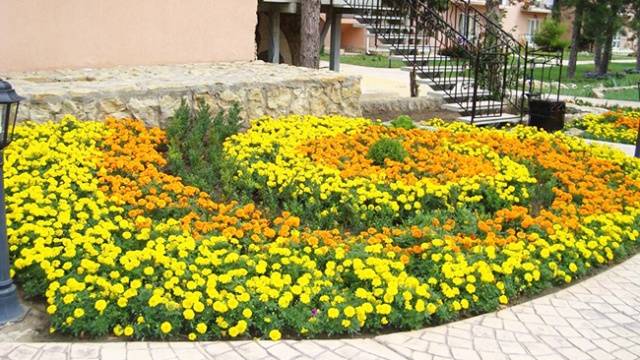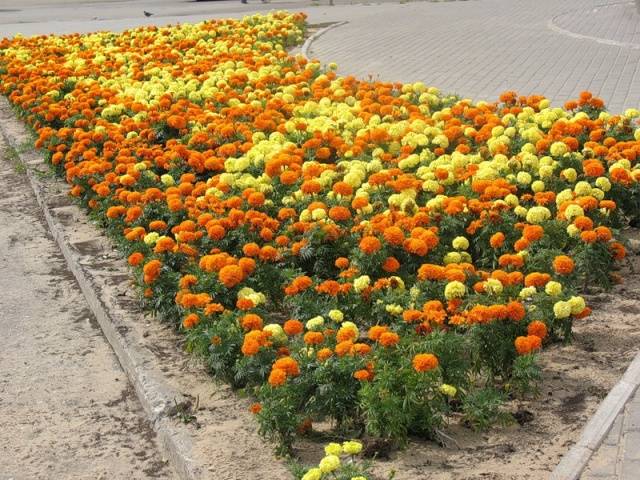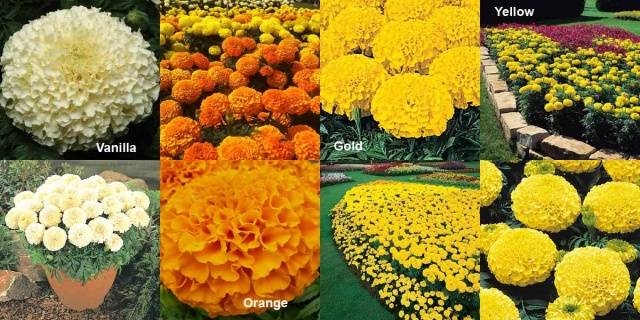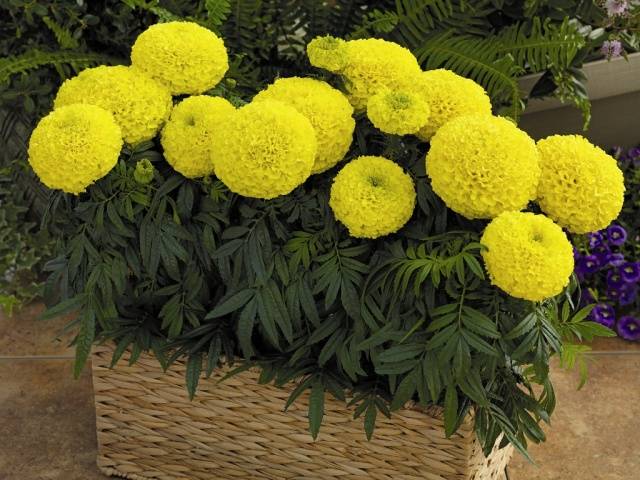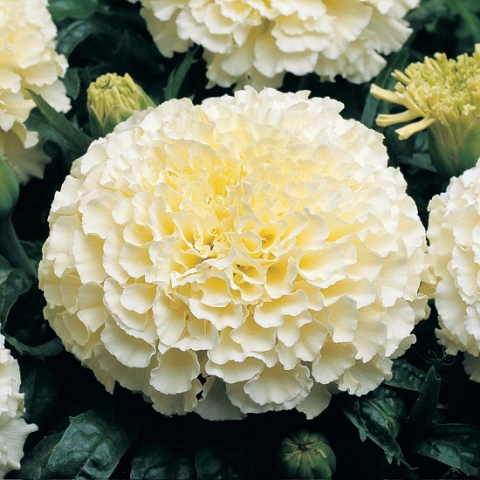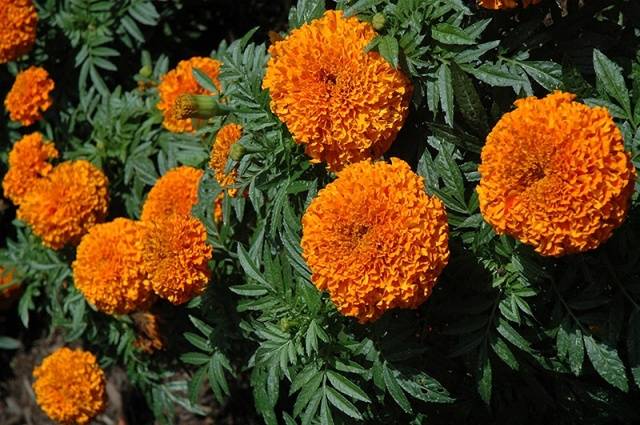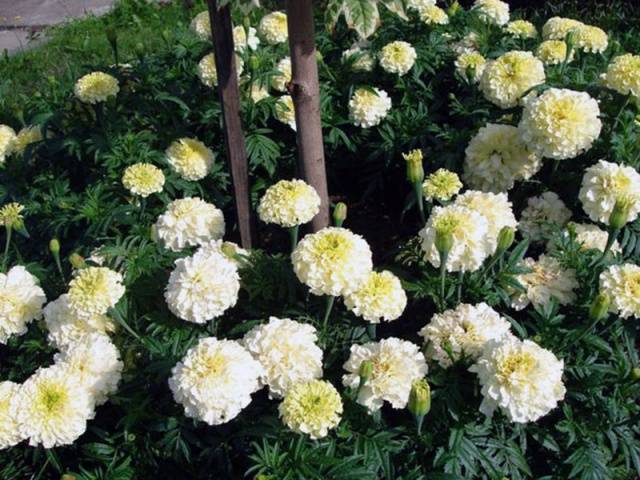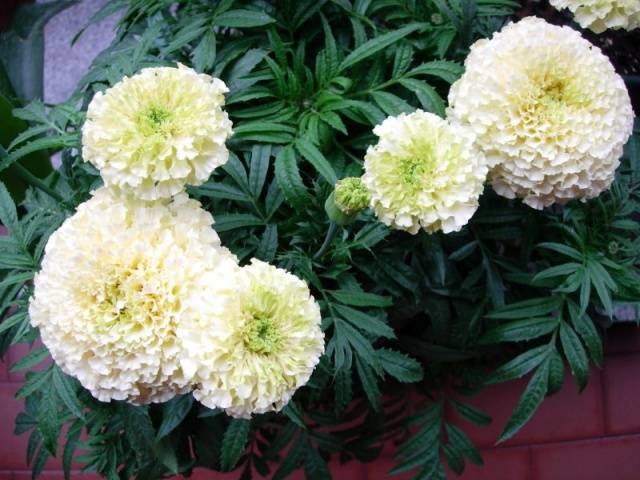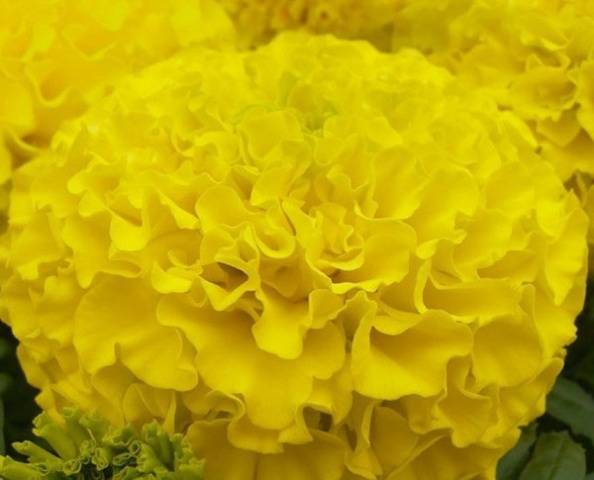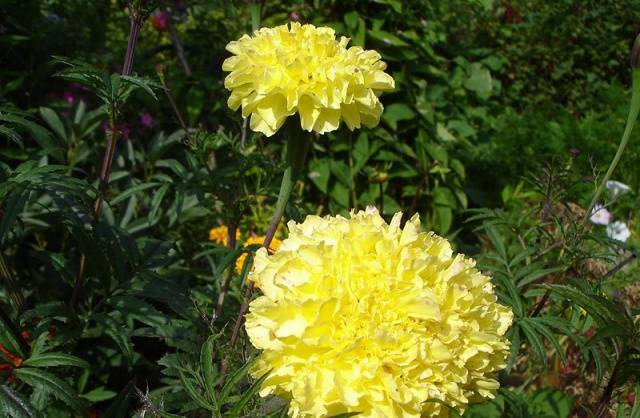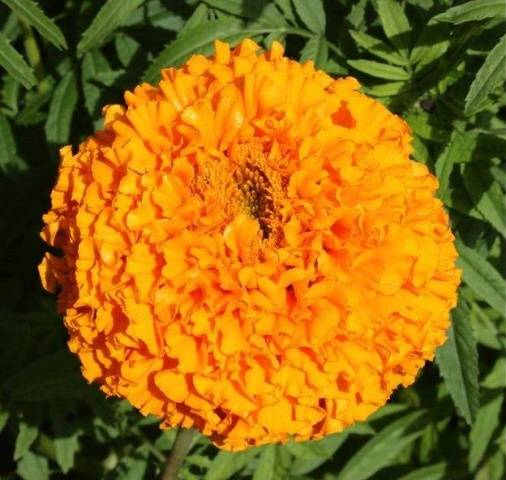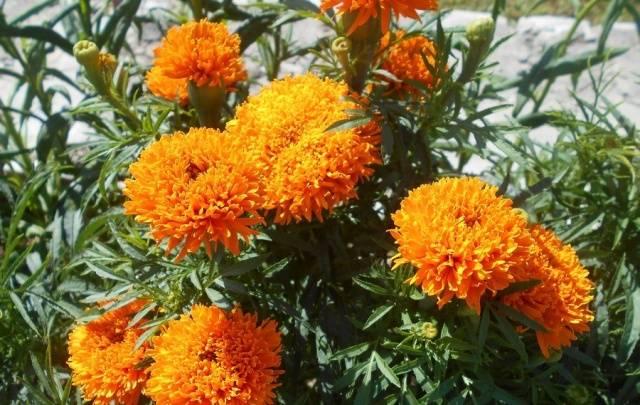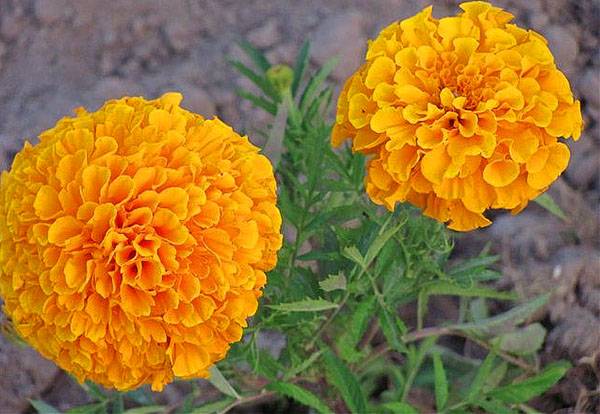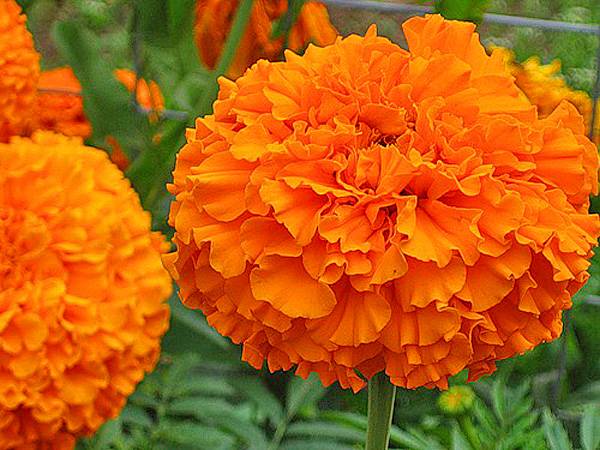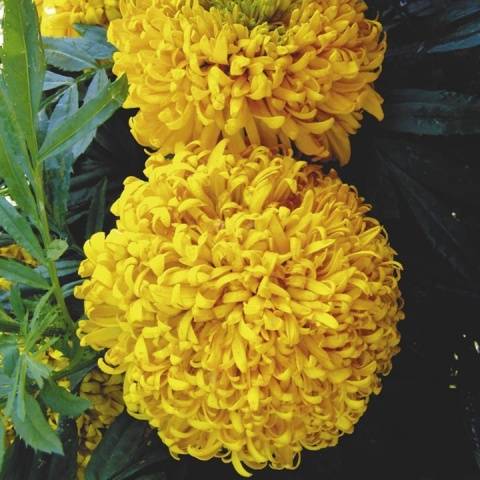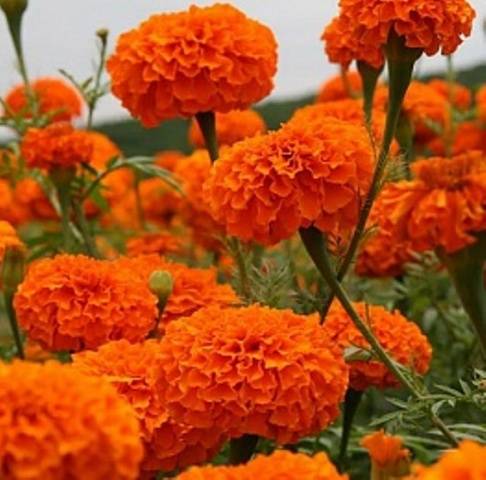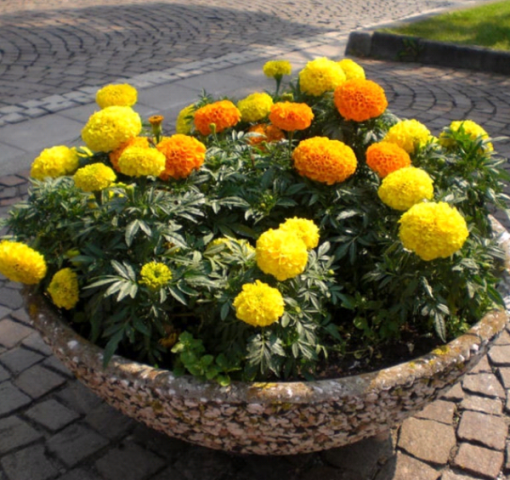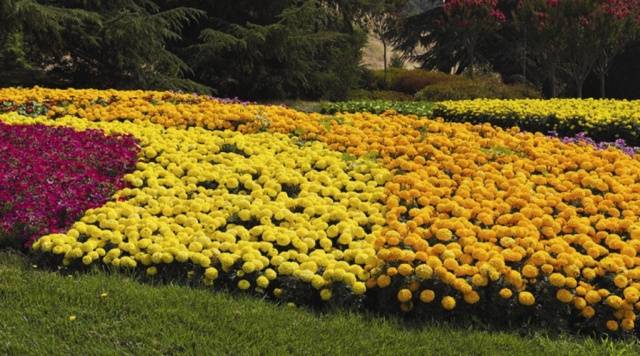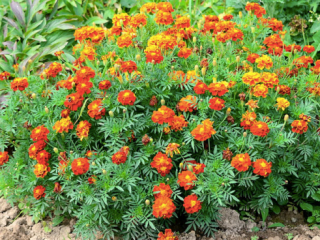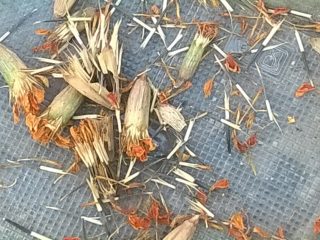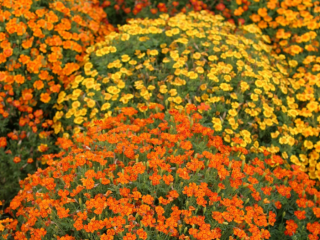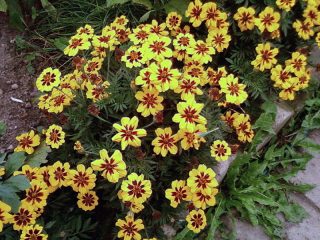Content
Marigolds - it is probably difficult to find a person who has never seen these flowers in his life. If you are characterized by practicality, and you like to combine business with pleasure, then these flowers are a real boon for you. Indeed, in addition to the cheerful and sunny mood that they are capable of emitting by their very appearance, marigolds can help you protect your garden and garden from harmful representatives of the animal kingdom, cure various diseases and improve the taste of many culinary dishes. Among the marigolds, you can find very tiny bushes, no more than 15 cm high, and garden giants, reaching a height of 120 cm.
Erect marigolds are the largest representatives of the numerous genus of marigolds. It is about them that will be discussed in this article.
Name history
Erect marigolds are sometimes called African, although the etymology of this popular name is very confusing. Indeed, by its origin, absolutely all types of marigolds known in nature are natives of the American continent. Why African?
But a related species of rejected marigolds is generally called French marigolds by the people. The fact is that after the conquest of America, these flowers originally came to Europe, more precisely, to France, in the 16th century. And from there they settled throughout Europe, and then penetrated into Russia. The heat-loving flowers that do not tolerate frost caused Russian gardeners to associate with distant hot Africa, and all marigolds were originally called African. A little later, the rejected marigolds began to be called French, and their former name remained behind the erect ones.
Description of plants
Erect marigolds belong to the typical annual outdoor herbaceous plants. They form powerful erect stems with a clearly defined central shoot. With age, the main stem lignifies at the base. The height of plants can be from 30 to 120 cm, but even low-growing flowers are very strong. Lateral shoots are also directed upwards, which is what differ, for example, from rejected marigolds.
The leaves are rather large, pinnately-divided with sharp lanceolate lobes with jagged edges. Their color can vary from light to dark green. Usually the leaves are arranged in a sequential order.
Erect marigold inflorescences are formed on long peduncles, and their size can be from 7 to 15 cm in diameter. They, as a rule, are single, have a double, less often semi-double shape.
Bloom on average 2 - 3 months after sowing seeds. Among the shades of flowers of erect marigolds, there are white, cream, yellow and orange. They differ mainly in the monochromatic color of the inflorescences, in contrast to the same rejected marigolds. There are about 300 seeds in 1 gram, the germination of which lasts only 1-2 years. Seeds can be harvested as early as 35-40 days after the start of flowering.
Classification of marigolds
Marigold bushes are often classified by height.
Distinguish:
- Stunted, up to 45 cm in height;
- Medium, from 45 to 60 cm;
- High, from 60 to 90 cm;
- Giants growing above 90 cm in height.
In terms of height, erect marigolds are also often distinguished:
- casing (low and medium);
- cut-off (most often high varieties that can stand in cut for up to 3 weeks).
Also, all marigolds are usually classified according to the shape of the inflorescences:
- Cloves consist mainly of several rows of wide ligulate flowers, which are sometimes fused and resemble tubular.
- Chrysanthemum flowers consist of highly overgrown tubular flowers that can be very dense or, conversely, loose, sticking out in different directions.
There are also densely double, spherical and semi-double inflorescences.
Varietal variety
Erect marigold varieties differ, first of all, in the size of the bush, in the shape and size of the inflorescences and their color.
Low-growing varieties
Low-growing varieties of erect marigolds appeared to meet the constant demand of flower growers for small flowers with huge, luxurious inflorescences that do not need to be tied up and from which, if desired, you can create colorful compositions with other plants.
Antigua
It is considered the most popular and widespread undersized hybrid. He was one of the first to appear. Despite its modest size in height (25-30 cm), it also grows in width up to 30 cm. And its inflorescences reach 10 cm in diameter. It has four colors: yellow, lemon, orange and gold.
Popsicle
Compact bushes with graceful foliage do not grow higher than 35 cm. Inflorescences are densely double, spherical, clove-like, but the petals are rolled into tubes. Flowers have a white color, rare for marigolds.
Munsong (Moonlight Song)
This hybrid is a novelty from American breeders. Dense inflorescences are so dense that they are even able to repel raindrops. The bushes grow well in width and retain their decorative effect for a long time. The period before flowering is about 3 months. The deep orange looks very attractive.
Amber
Plants of this variety are characterized by uniformity in habit and height. Flowering begins quite early, 2.5 months after sowing, and lasts a long time in any even the most unfavorable weather conditions.
Average
In this group in terms of height, the leadership is occupied by rejected marigolds, and among the upright varieties, the choice is not so large. But the ones that exist are worthy of mention.
Aztec lime green
The very name of this hybrid alludes to the unique lime-greenish color of the flowers. Plants are compact and medium in size, although the inflorescences cannot be called medium, their size reaches 10-12 cm in diameter.
Vanilla
The color of the flowers of this hybrid is dominated by vanilla-white color, and the yellow center only emphasizes the decorativeness of the inflorescences. The size of the bushes is medium, 45-50 cm in height and 30 cm in width. The inflorescences are not the largest - about 7-8 cm in diameter.
Alaska
The variety is similar in many respects to the previous hybrid, but the inflorescences are distinguished by an exclusively light cream color.
Solar giants
This series is famous, first of all, for the gigantic size of the inflorescences, which can reach 15 cm or more. Orange and lemon solar giants are found in color. At the same time, the size of the bushes themselves is more than modest, in height it does not exceed 50 cm.
High
The largest group in terms of variety of varieties. After all, it was with these sizes that the first varieties of erect marigolds began.
Kilimanjaro
One of the most popular varieties of marigolds with a white color. Somewhat resembles an Eskimo, but the bushes grow up to 70 cm in height and look much more powerful.
Yellow stone
Medium-sized golden or light yellow inflorescences (7-8 cm) have a lush chrysanthemum shape and look very attractive in bouquets.
Golden light
The bushes are tall but compact.Shoots are ribbed, have a slight reddish bloom. Carnation inflorescences, although lush, do not reach the shape of a ball. The variety is distinguished by its late ripening period, blooms 3-3.5 months after sowing.
Lemon Prince
The inflorescences of this variety are also cloves, but they are especially splendid. The lemon-yellow color of the inflorescences looks attractive against the background of dark green rugged leaves.
Orange princess
And this variety is able to shake the saturation of the orange hue of its inflorescences, which reach 10-12 cm in diameter.
Fantasy
A series of new varieties of various shades are distinguished by chrysanthemum-shaped lush inflorescences, although they look slightly disheveled.
Giants varieties
Erect marigolds, growing more than a meter in height, will look great in the background of the border, along with other tall plants such as snapdragons, delphiniums and foxgloves. True, even despite the strong and very strong central trunk, it is advisable to tie the bushes to supports or plant in places protected from the wind.
Gold dollar
The variety, despite its impressive size, is quite early. Plants bloom 2.5 months after sowing. Inflorescences of a dense orange hue, chrysanthemum, reach 8-9 cm in diameter. The gold dollar is distinguished by the absence of a peculiar smell characteristic of marigolds.
Hawaii
It is also a giant of upright orange marigolds, but the flowers have a clove-like shape and are larger in size, reaching 12-14 cm in diameter.
Guilbert Stein
The attractive light golden color of the inflorescences and the spherical shape make this variety popular for both cutting and growing in flower beds.
The Velvet season
This variety appeared quite recently and managed to attract the attention of flower growers both with the huge size of the bushes and inflorescences, which reach a diameter of 15 cm or more. In addition, the densely colored globular inflorescences in three different shades are excellent in cut.
Growing features
Of all the three types of marigolds most often cultivated in our country, erect marigolds impose the highest requirements on the quality of soils and the amount of light they need for full flowering. It is best to grow them in a sunny place; in partial shade, they will not be able to demonstrate all their best qualities. Growing soils must be fertile, as giant buds and bushes need a lot of nutrition to look good.
Accordingly, the growing season for this variety of marigolds is longer. If you want erect marigolds to please you with flowering already from the beginning of June, then they must be sown for seedlings from the beginning of March. They are practically unsuitable for sowing in open ground, except in the southernmost regions of the country. And then in this case they will be able to bloom only in the second half of summer.
Seeds can be sown in any containers convenient for you, since marigold seedlings easily tolerate transplanting at any age, and even being in a flowering state. Seedlings usually appear on day 4-6, plants develop optimally at a temperature of + 18 ° + 20 ° C.
If you sow seeds quite often, then when two true leaves appear, the sprouts should be planted at a distance of 7 cm from each other with row spacing of 7 cm.When planting in open ground, the bushes should be slightly deepened into the ground by 1-2 cm for better rooting.
Low-growing and medium-sized varieties can be planted according to the 20x20cm scheme, and for tall giants it is necessary to leave at least 40 cm between plants when planting.
When growing, you should pay attention to the following possible difficulties:
- Marigolds are very thermophilic, they die already at -1 ° -2 ° C. If the air temperature is less than + 10 ° C, the plants stop growing, the leaves acquire a purple hue, and the flowering decreases.
- At the beginning of growth, plants need an abundance of moisture, after flowering, they can withstand up to 10 days without watering.
- In rainy weather, very large double inflorescences can rot from excessive moisture.
- More demanding on nutrition from all types of marigolds.
- If high air temperatures are combined with high humidity, then the bushes will have an abundance of leaves with a minimum of inflorescences.
If possible, be sure to settle erect marigolds in your garden, and these spectacular giants will surely delight you with lush flowering and luxurious bouquets of the color of the sun.
